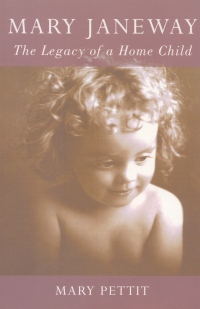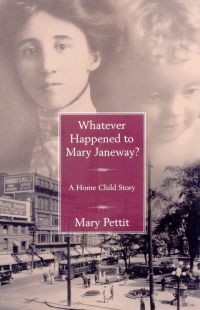| ________________
CM . . .
. Volume XIX Number 21. . . .February 1, 2013
excerpt:
Hamilton, ON, educator Mary Pettit had as her godmother a kindly lady called "Mrs. Church", who entered her life as a visiting homemaker when Pettit was an infant. Eventually learning more about Mary Janeway Church, Pettit produced two literary labours of love about the older woman's life. In Mary Janeway: The Legacy of a Home Child, Pettit presents Mary's unhappy childhood in the late 19th and early 20th century. Whatever Happened to Mary Janeway reflects Pettit's further research on the Janeway family and covers Mary Janeway Church's life from age 16 until her death in 1961. Mary Janeway's early experiences were typical of those of the 100,000 poor children brought from Britain to Canada between the 1860s and the 1930s. Not all were orphans. Many, like Janeway and her siblings, had lost one parent but had another who was impoverished and overwhelmed. The Church of England and several private philanthropic societies attempted to rescue destitute children, place them in institutional residences (the most famous being Dr. Thomas Barnardo's Homes) and ultimately arrange their placement in the colonies and dominions mainly Canada as farm labourers or domestic servants. In February 2012, British Prime Minister Gordon Brown apologized to the surviving "child migrants" on behalf of Britain for robbing them of their childhood. The agencies did not adequately supervise the environments in which the children were placed and failed to ensure that they received proper food, shelter, allowances and education. In his landmark history, The Little Immigrants (1980), Kenneth Bagnell says that most of these children were exploited as cheap labour. Certainly, Mary Janeway was. Just before her sixteenth birthday, she left the farm where she was being overworked. She dreamed of being reunited with her siblings, and she eventually succeeded in regaining contact with most of them. Sadly, the collapse of her marriage and her lack of education limited her to domestic work in other people's homes for most of her life. Although CIP data categorizes Mary Janeway: The Legacy of a Home Child, as fiction, Pettit emphasizes the real life elements in the story. "Mary Janeway is a real person," Pettit wrote in her author's note. "The Jacques family did live outside Innerkip. Not all the characters, however, are real...I have taken some literary liberties and indulged in some embellishments, while conscious of preserving the integrity of my story." The quotes from Kenneth Bagnell at the beginning of each chapter of The Legacy of a Home Child, and the archival photos illustrating life in rural Ontario in the late 19th and early 20th centuries, give the first impression that the book is not a novel, but a history text. Some readers may find these historical elements an obstacle to getting caught up in the story. In Whatever Happened to Mary Janeway?, Pettit explains that the principal "characters" are real, but "[T]he rest are fictional characters, threads of the author's imagination and interwoven to create a backdrop to the story in an attempt to tell and understand Mary's life." This book seems like nonfiction because of the amount of information about Janeway's life and times. The photos of Mary's family and friends, and of the towns where she lived, add to the impression that Whatever Happened is nonfiction. Possibly Pettit would have preferred to have stayed in the realm of history by writing a biography of Janeway but was faced with gaps in her knowledge of Janeway's story and chose fictionalization as the best way of filling them. Also, Pettit may draw attention to the "true" and "real" elements in her books in the belief that a reality based story is more worthwhile than a work which is completely of the imagination. This belief seems prevalent nowadays, with nonfiction works selling better than novels. In the ideal historical novel, history blends smoothly and unobtrusively with imagination and invention. Carolyn Pogue's 2009 "home child" novel, Gwen (Vol. XVI, No. 27, March 19, 2010), inspired by her grandmother's story, is a powerful work of fiction which effectively conveys an immigrant child's plight. Clearly, Mary Janeway and the other "home children" deserve to be remembered, and Pettit deserves praise for showing readers her godmother's years of struggle and her humble but valuable contribution to Canada Recommended. Residing in Ottawa, ON, Ruth (Olson) Latta (M.A., History, Queen's) has written a biography and several novels.
To comment
on this title or this review, send mail to cm@umanitoba.ca.
Copyright © the Manitoba Library Association. Reproduction for personal
use is permitted only if this copyright notice is maintained. Any
other reproduction is prohibited without permission.
NEXT REVIEW |
TABLE OF CONTENTS FOR THIS ISSUE
- February 1, 2013.
AUTHORS |
TITLES |
MEDIA REVIEWS |
PROFILES |
BACK ISSUES |
SEARCH |
CMARCHIVE |
HOME |

